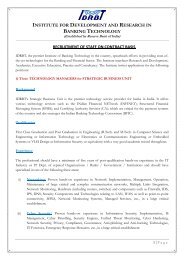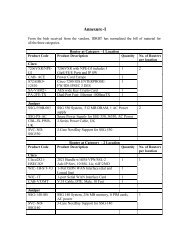New method for feature extraction based on fractal behavior - IDRBT
New method for feature extraction based on fractal behavior - IDRBT
New method for feature extraction based on fractal behavior - IDRBT
Create successful ePaper yourself
Turn your PDF publications into a flip-book with our unique Google optimized e-Paper software.
Y.Y. Tang et al. / Pattern Recogniti<strong>on</strong> 35 (2002) 1071–1081 1073<br />
the comm<strong>on</strong> value is called box computing dimensi<strong>on</strong> or<br />
box dimensi<strong>on</strong> of F, namely<br />
log<br />
dim B F = lim 2 N (F)<br />
→0 −log 2 : (4)<br />
Further discussi<strong>on</strong>s <strong>on</strong> <strong>fractal</strong> theory can be found in<br />
Refs. [11,12,10].<br />
The modied box computing dimensi<strong>on</strong> <str<strong>on</strong>g>method</str<strong>on</strong>g> gives<br />
a very goodestimate of <strong>fractal</strong> dimensi<strong>on</strong>. It can be easily<br />
shown that computati<strong>on</strong> complexity of other approaches,<br />
including the original box counting dimensi<strong>on</strong>, is much<br />
higher than that of this approach. Thus it has the advantages<br />
of simplicity in computati<strong>on</strong> andimprovement in<br />
eciency.<br />
2.3. Minkowski dimensi<strong>on</strong> and modied <strong>fractal</strong><br />
signature<br />
There is an important equivalent deniti<strong>on</strong> of box<br />
counting dimensi<strong>on</strong> of a rather dierent <str<strong>on</strong>g>for</str<strong>on</strong>g>m that is the<br />
-parallel body F of F.<br />
F = {x ∈ R n : |x − y| 6 ; <str<strong>on</strong>g>for</str<strong>on</strong>g> y ∈ F}: (5)<br />
If F is a subset of R n and, <str<strong>on</strong>g>for</str<strong>on</strong>g> some d, if the limit of<br />
[Vol n (F )]= n−d tends to be positive and nite as → 0,<br />
then it makes sense to regard F as d-dimensi<strong>on</strong>. The<br />
limiting value is calledthe Minkowski dimensi<strong>on</strong> of F,<br />
nameddim M F. Vol n (F ) is Lebesgue measure of F.<br />
Even if this limit does not exist, we may be able to extract<br />
the critical exp<strong>on</strong>ent of andthis turns out to be<br />
relatedto the box dimensi<strong>on</strong>. The initial andkey step <str<strong>on</strong>g>for</str<strong>on</strong>g><br />
Minkowski dimensi<strong>on</strong> is to evaluate the Vol(F ) under<br />
dierent .<br />
The relati<strong>on</strong>ship between the box counting dimensi<strong>on</strong><br />
and Minkowski dimensi<strong>on</strong> can be provided by the following<br />
equati<strong>on</strong>:<br />
log<br />
dim B F = n − lim 2 Vol n (F )<br />
;<br />
→0 −log 2 <br />
log<br />
dim B F = n − lim 2 Vol n (F )<br />
; (6)<br />
→0 −log 2 <br />
where F stands <str<strong>on</strong>g>for</str<strong>on</strong>g> -parallel body of F, and<br />
Vol n (F ) denotes n-dimensi<strong>on</strong> area or volume of F .<br />
For a n<strong>on</strong>empty andboundedset F in R n , we have<br />
dim M F =dim B F.<br />
Let F = {X i;j };i=0; 1;:::;K; j=0; 1;:::;L be the<br />
image of a pattern with multi-gray level, and X i;j be<br />
the gray level of the (i; j)th pixel. In a certain measure<br />
range, the gray level surface of F can be viewedas a<br />
<strong>fractal</strong>. The surface area can be usedto approximate its<br />
<strong>fractal</strong> dimensi<strong>on</strong>.<br />
In particular, the gray level functi<strong>on</strong> F is a n<strong>on</strong>empty<br />
andboundedset in R 3 <str<strong>on</strong>g>for</str<strong>on</strong>g> either text areas, graphics<br />
areas or backgroundareas in the pattern. We use a<br />
Fig. 1. Surface andits blankets.<br />
technique that is referredto as Blanket Technique [13]<br />
to thicken the functi<strong>on</strong> F. It leads to a set F , which is<br />
still a n<strong>on</strong>empty andboundedset in R 3 . According to the<br />
deniti<strong>on</strong> of Minkowski Dimensi<strong>on</strong> andRef. [5], we can<br />
c<strong>on</strong>clude that if<br />
Vol 3 (F<br />
lim )<br />
= ¿0;<br />
→0 3−D<br />
then<br />
D =dim M F =dim B F;<br />
where denotes a c<strong>on</strong>stant, Vol 3 (F ) stands <str<strong>on</strong>g>for</str<strong>on</strong>g> the volume<br />
of the blanket F .<br />
The idea of the blanket technique is <str<strong>on</strong>g>based</str<strong>on</strong>g> <strong>on</strong> the<br />
equivalent deniti<strong>on</strong> of the box computing dimensi<strong>on</strong><br />
shown in Eq. (5), i.e. the -parallel body. In the blanket<br />
technique, all points of the three-dimensi<strong>on</strong>al space at<br />
distance from the gray level surface are c<strong>on</strong>sidered.<br />
These points c<strong>on</strong>struct a “blanket” of thickness 2 covering<br />
this surface. A graphical illustrati<strong>on</strong> is shown in<br />
Fig. 1. The image is representedby a gray-level functi<strong>on</strong><br />
g(i; j). The covering blanket is dened by its upper<br />
surface u (i; j) andits lower surface b (i; j).<br />
• Initially, = 0 andgiven the gray-level functi<strong>on</strong><br />
equals the upper andlower surfaces, namely:<br />
g(i; j)=u 0 (i; j)=b 0 (i; j):<br />
• For =1; 2;:::, the blanket surfaces are dened as<br />
follows:<br />
u (i; j)<br />
{<br />
= max u −1 (i; j)+1;<br />
b (i; j)<br />
{<br />
= min b −1 (i; j) − 1;<br />
}<br />
max u −1 (m; n) ;<br />
|(m;n)−(i;j)|61<br />
(7)<br />
}<br />
min<br />
|(m;n)−(i;j)|61<br />
b −1 (m; n) :<br />
(8)

















